The Heat Capacity Mapping Mission (HCMM)
On April 26, 1978 NASA launched a sensor system capable of measuring
temperatures and albedo, from which the apparent thermal inertia
(ATI) of parcels of the Earth's land and sea surfaces can be estimated.
This was called the Heat Capacity Mapping Mission (HCMM). It used
a two channel radiometer: one channel detected visible to near-
IR radiation, 0.5 to 1.1 µm, and the second detected emitted thermal
IR, 10.5-12.5 µm interval. Following a near polar, Sun-synchronous
retrograde orbit at a nominal altitude of 620 km (385 miles),
the orbital configuration was designed to pass in its ascending
mode (S to N) over acquisition targets in the early afternoon
(~2:00 P.M. at the equator) along pathways inclined at 7.86° to
longitudinal lines. Night passes are also inclined at 7.86° but
in opposing orientation relative to longitudinal lines, to which
the day and night paths are thus symmetrical. A night pass, in
an descending mode (N to S), covers its target between 1:30 and
2:30 A.M. local time. The same area is imaged about 12 hours apart
(one-half diurnal cycle; 8 orbits) at latitudes from 0 to 20°
and 35 to 78° or 36 hours difference (one and a half cycles) between
20 and 35° latitude (of course, cloud cover will compromise some
images). The repeat cycle - covering approximately the same area
in the day-night pattern - is 16 days. The altitude and sensor
optics produce a swath width of 715 km (445 miles) and a spatial
resolution of 500 m (1650 m) for the visible channel and 600 m
(1980 ft) for the thermal channel (whose sensitivity [ability
to discriminate differences] is ~ 0.4°K at 280°K).
Since the day and night passes over the same areas were acquired
along paths at opposing inclinations, and individual pixels scanned
by the thermal sensor do not precisely cover the same ground areas
(IFOVs), i.e., do not coincide, equivalent ground plots must be
co-registered using a computer program that utilizes specific
control points (features recognizable at the 600 m resolution).
Once pixel sets are thus registered, temperature differences (delta
T) for a particular cycle can be calculated from the values obtained
at the mid-afternoon and middle of night times (note that delta
T will not be maximum since the coolest time is several hours
later around dawn). The apparent albedo 'a' (ranging from 0 to
1 [maximum; equivalent to 100% reflection]) can be derived from
the Day Visible channel values. These are the sensor-obtained
values needed to calculate ATI according to the formula: , where N is a scaling factor and C is a constant related to the
solar flux (irradiance) generalized for a given latitude. Images
made to show variations in ATI for a scene show high values (small
delta Ts and/or low albedos) as light tones and low as dark. Day
and Night temperature images follow the usual convention of light
as warm and dark as cool. Interpretation of these images must
be made cautiously, as many of the factors mentioned earlier in
this section can affect the temperature state at any or all point(s)
and usually can't be controlled for. ATI, then, is only an approximation.
We begin our look at HCMM images with this instructive full Day Vis scene
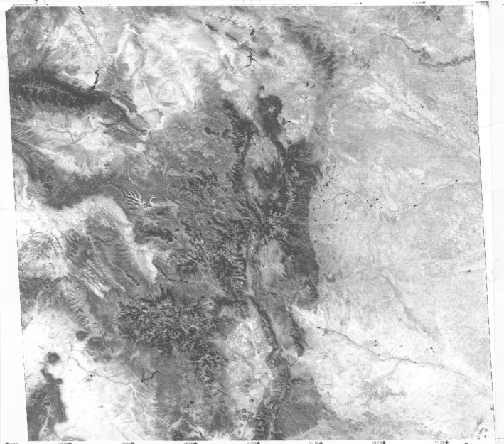
that extends for more than 640 km (400 miles) across and in so doing completely encompasses the state of Colorado as well as parts of surrounding states from the Great Plains in Kansas west into Utah and north into Wyoming, as located in the accompanying map.
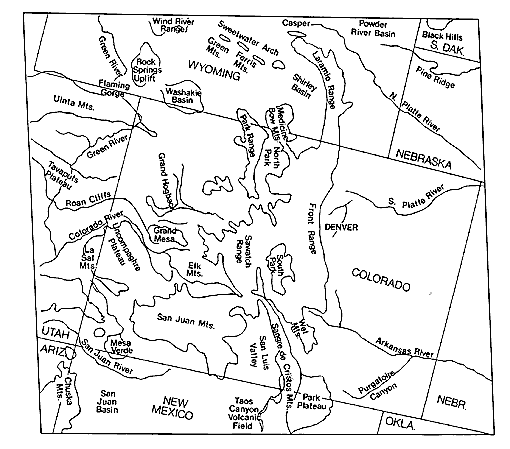
The Rocky Mountains stand out by their dark tones - caused mainly by coniferous vegetation - in sharp contrast to the lighter tones associated with the Plains and Basins. Anyone who has lived or vacationed anywhere in this scene will be intrigued in trying to locate the areas visited. The lofty Rockies are somehow less impressive when "flattened" in this image.
To gain a feel for the thermal images, let us examine several HCMM scenes that capture a part of the northeast U.S. and neighboring Canada. Look first at a 467 km (290 mile) wide section extracted from a full Day VIS-Near IR image obtained on September 26, 1978.
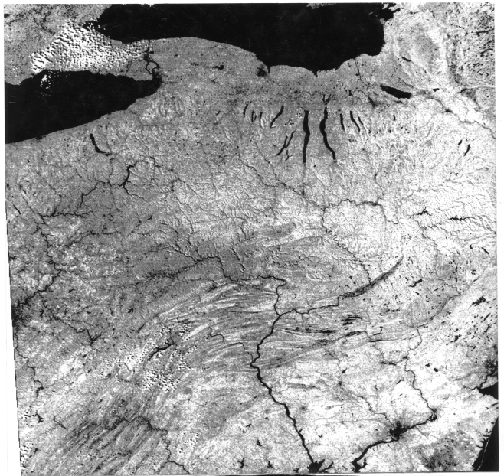
The largest scale features are Lakes Ontario and Erie. The Finger Lakes of New York are evident. The main rivers in the scene are the Susquehanna and Delaware Rivers, visible mainly in the lower right third of the image. Philadelphia and New York City appear as dark tones; compare this image with the MSS Band 5 view of the same area shown in the Overview. The regional geology is dominated by the Coastal Plains and Piedmont (lower right), the fold belt of the Appalachians, the Appalachian Plateau, and glaciated upstate New York into Canada (upper left). In the right center is a narrow, curved dark pattern that identified as the Wyoming Valley of eastern Pennsylvania (Wilkes-Barre/Scranton areas), a major anthracite coal belt. Note the few cumulus clouds.
The Day Thermal image taken at the same time presents distinct differences.
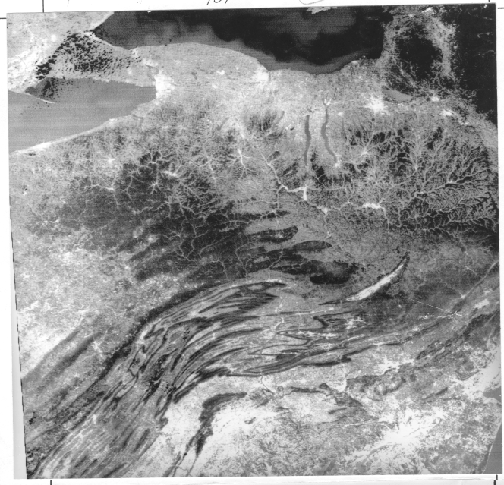
The thermal structure of the lakes is evident; as in the TM 6 image, Lake Erie is warmer than Lake Ontario. The white clouds west of Buffalo are depicted as very dark (cold) in the thermal image, consistent with their generally low temperatures as condensation in the atmosphere. Much of the land is shown in medium grays. Very dark areas are associated with the fold ridges and with sections of the Appalachian Plateau. These relate to heavy deciduous tree cover in these mountainous areas; the trees locally cool their surroundings by evapotranspiration. Five major metropolitan areas - Buffalo, Rochester, Syracuse, New York City/New Jersey, and Philadelphia/Wilmington - stand out as very light tones, indicative of the warmer temperatures usually experienced in cities. A few rural areas also are light (warm) for reasons not obvious. But the Wyoming Valley is segregated from its surroundings by its very light tone, the result of higher radiant temperatures determined by the widespread occurrence of dark shale mixed with black coal dust (blackbody effect).
A nearly cloud free full image of much the same area (but extending into western
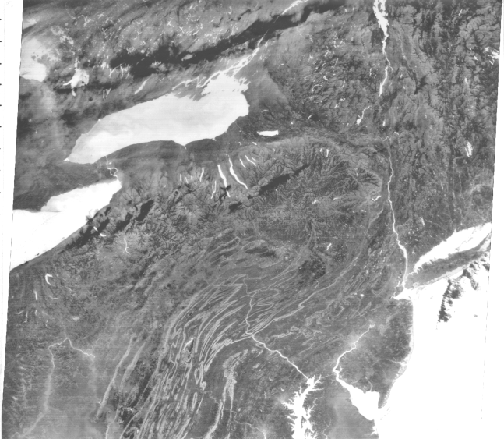
New England, across Long Island and down to the mid-Chesapeake Bay) was obtained in the night of November 2, 1978. Lakes, rivers, and the ocean show as much warmer water bodies than the cooler land. (This is a seeming paradox: even though water has cooled down somewhat during the night, it normally experiences smaller delta Ts than the land; during the day water is notably colder than the land which has warmed up to higher temperatures and in the night it shows up as warmer than the land because of its heat retention and the commonly larger drop in land surface temperatures. This may be clarified by considering this plot.
This shows the assignments of gray tones as a function of radiant temperatures for the Day and Night images. Here, a temperature of 285 °K on the land has a darker gray level than a temperature of 270 °K for that same surface in the night. If (case not shown in the plot), water during the day had a temperature of 280 °K and dropped at night to 275 °K, you can extrapolate these values to the two straight line plots: the 280 °K gray level would be very dark and the 275 °K level would be lighter than the corresponding land value. This reasoning accounts for the relative land-water gray tones noted in the Day-IR and Night-IR images shown above.
In the night-IR image, cities are slightly warmer than their surroundings. The ridges in the folded Appalachians appear warmer, largely because they have dropped their leaves (thus, no longer cooling by evapotranspiration) and underlying rock units contribute to the thermal response. The Wyoming Valley is not emphasized by warm emission from the coal/dark soil surface and is only locatable from the ridge pattern enclosing it. Some valleys appear conspicuously dark, owing perhaps to cold air drainage from uplands. Dark cloud banks (cold) are evident north of Lake Ontario.
The first ever ATI image was produced from satellite observations of this eastern U.S. area (HCMM Day images on May 11 and a night image on June 11, 1978)
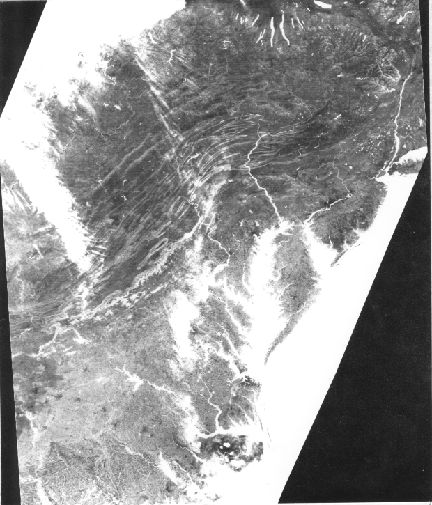
Water has a very bright tone, as do clouds (upper left) and snow (not in this image). The value of (1 - a) is near maximum for water (with a moderate delta T), hence a large ATI. But, for clouds and snow, both having high albedos, thus tending to lower ATI, the delta T is quite low, countering the (1 - a) effect by raising ATI (because of its position in the denominator). A typical ratio of (1 - a)/delta T for water is 0.98/3 = 32.7, for snow is 0.40/2 = 20.0, and for moderately reflective soils is 0.70/20 = 3.5. As a generalization, vegetation has moderate to low ATIs, as do many soils, while basalt has a very low and granite a moderate to high ATI. Heavily forested areas in the Appalachians are dark, denoting low ATIs. Those in the Piedmont and Coastal Plains, where soils are better exposed because of less trees, are somewhat higher; the Piedmont can be crudely separated from the Plains by its lighter tones.
The same Day thermal image used as partial input in making this ATI image reveals, when colors are assigned to the different calibrated temperatures, a prominent thermal pattern in the Atlantic ocean.
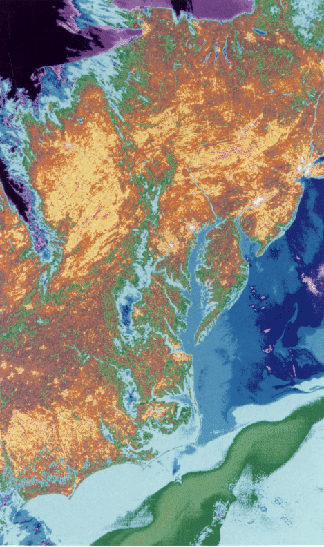
Several shades of darker blue mark zones of colder water. Near the bottom, within a lighter blue body, is a greenish curving pattern that represents the somewhat warmer Gulf Stream moving northward enroute to the Outer Banks off Newfoundland.
HCMM was operated to prove, or get further insights into, applications in most of the same disciplines as addressed by the Landsat program. Among the objectives successfully investigated were:
Consider this definitive example of a geological application of HCMM data, developed by Anne Kahle and her associates at the Jet Propulsion Laboratory.
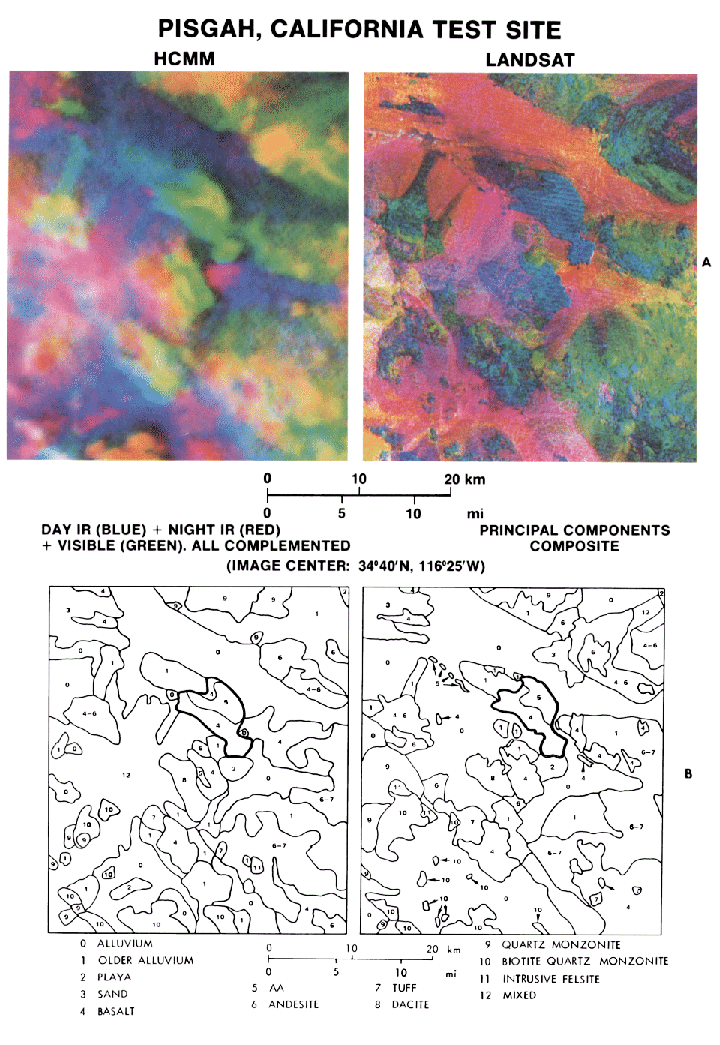
The area examined is in the eastern Mojave Desert of California, in which basin and range topography similar to the Death Valley region dominates the landscape. The color image in the upper right is a Principal Components Composite using the four Landsat MSS bands. Correlation of color units with rock types and deposits mapped in the field is expressed in the map at lower right. Of particular interest is the heavy lined feature near center which encompasses a basaltic cinder cone and associated lava outpourings known as the Pisgah Crater. The corresponding scene (upper left) constructed as a composite of HCMM Day IR (blue), Night IR (red) and Day Visible (green) shows both similarities and differences. Alluvium clearly differentiates in blue tones; more silicic volcanics appear in red. The lava flow emanating from Pisgah Crater is seen now to consist of two units poorly separated in the PCA product: basalt with a pahoehoe like (ropy) texture and basalt with aa (cindery) texture.
Finally, we look at a fascinating special product,
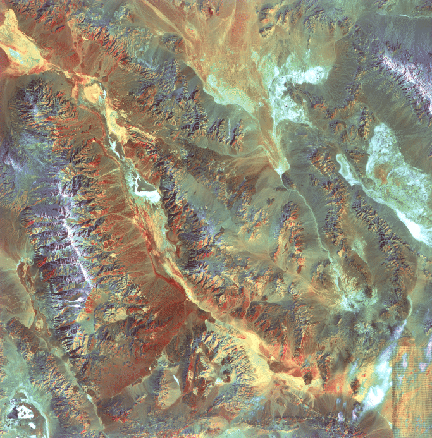
produced by Rupert Haydn of Bavaria, in which the Death Valley Landsat scene (here cropped to show only the northwestern 60%) in which a TM 4 image (I) is convolved with the TM 6 thermal image (H) and also with a HCMM Day IR image (S). The letters in parenthesis refer to a different method for making color composites known as the IHS system, where the three primary colors are assigned to derived intensity (I), hue (H), and saturation (S) parameters. Again, reds denote hot, blues cool, and yellows and greens intermediate temperatures. As with the TIMS imagery, the alluvial fans show in reds, some salt deposits in blues and greens, and certain playa beds in yellow.
We can safely conclude from this review that thermal imagery opens up new vistas in seeing the Earth's surface in a way largely unfamiliar to our experience. Thermal sensing is a versatile way to detect and identify features using properties we ourselves seldom sense directly - certainly not with our eyes. You no doubt have seen two other kinds of thermal images not considered in this section: views of people and action picked up by "night vision" methods (a variant was amazingly presented as targets being zeroed in on in Iraq during the 1991 Gulf War); and views of heat concentrating or escaping around a home being surveyed by thermal scanners for heat leaks. Hot stuff, eh!
Code 935, Goddard Space Flight Center, NASA
Written by: Nicholas M. Short, Sr. email: nmshort@epix.net
and
Jon Robinson email: Jon.W.Robinson.1@gsfc.nasa.gov
Webmaster: Bill Dickinson Jr. email: rstwebmaster@gsti.com
Web Production: Christiane Robinson, Terri Ho and Nannette Fekete
Updated: 1999.03.15.